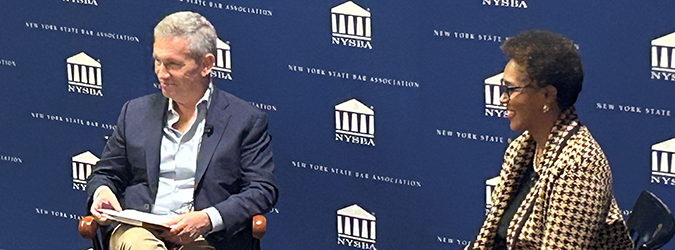How To Manage Time, Set Priorities and Reduce Anxiety
3.31.2023

Effectively managing time takes effort, but breathing, slowing down and prioritizing are a good way to start.
That was the message from Alyssa Malin, former in-house counsel to a New York City real estate investment firm who switched to life coaching. Nowadays, she runs The Stet Collective, which is focused on helping female lawyers with professional development and wellness.
On March 29, the New York State Bar Association hosted a seminar featuring Malin speaking about time management for lawyers. The seminar was sponsored by the association’s Women In Law Section, the Committee On Law Practice Management and the Committee On Continuing Legal Education.
Setting Priorities
Malin said women are often prone to perfectionism and taught to take care of others before themselves, and that carries over into the workplace. “When we have a priority that is not in line with that gender norm, it results in some guilt,” she said.
She said that the term work-life balance is a misnomer and that it’s better to strive for being present and focused instead. “I obviously can’t tell you how to prioritize,” said Malin. “Everyone’s life is different, and everyone’s desires for how they want to live are different.” She added that a list of priorities should also include what a person wants in their personal life as well as the workplace.
Malin said people should write down their top five priorities and then look at how they are spending their time. “It’s a little bit uncomfortable because you’re going to see that you may not be living according to your values,” she said. “But it’s a really effective exercise.”
Reducing Anxiety
Anxiety is the number-one productivity killer and the most common issue Malin sees in her practice. She added that anxious people tend to procrastinate and avoid their work – often by doing other less-important tasks.
“The anxious brain is not a clear-thinking brain,” Malin said. “Paranoid thoughts start to seem rational to us, and we have trouble differentiating between reasonable arguments and unreasonable arguments.”
The first step to reducing anxiety is to address the physical components, like twitching, clammy hands, nausea, chest tightness and difficulty breathing. These sensations are caused by the release of cortisone and adrenaline. “The primitive brain is responsible for our stress response,” Malin said. “And it hasn’t evolved enough to differentiate between a lion that was going to eat us and an email from an upset client.”
Using words to describe the physical symptoms distracts the brain from what’s causing the anxiety and shows that those thoughts, while stressful, are not life-or-death. “You are not in physical danger; you are just feeling an uncomfortable physical sensation,” Malin said. “And that’s really all anxiety is.”
The second step is to address the thought that is causing anxiety. As Malin described, thoughts create feelings, which create actions, which create results. “I recommend writing down these thoughts to see that they’re just thoughts,” she said. “They are not facts.”
Malin recommended coming up with an alternative – yet believable – thought that feels better than what is causing the anxiety. “I call it thought work,” she said. “It’s a really awesome tool, and it’s a tool that lawyers are particularly cut out for because… we’re always training to be thinking of alternative explanations, other ways to look at a problem, other ways to interpret at the facts.”
Effective Planning
When tasks are overwhelming, it helps to make a plan and then execute the plan later. “This way you’re telling your brain that… you don’t have to actually do the work,” said Malin. “And that is much more calming to the brain. It’s much less overwhelming. And once you’ve made that plan, all you have to do is follow it.”
She also said it’s important to limit distractions, like turning off notifications. Even if one cannot ignore all messages, it helps to only allow notifications from the most important people.
Overall, the key to effective time management is practice, consistency and finding what works for an individual. “The truth is there’s no organizational system that’s perfect,” Malin said. “There’s just the system that is perfect for you.”
Laura Sulem, the chair of the Women in Law Section’s Annual Meeting and Programming Committee, delivered the opening remarks. The full program is available here.






